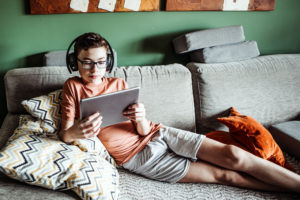September 1, 2021
By Dwight Akerman, OD, MBA, FAAO, FBCLA
 Smartphone use is a relatively new behavior among youth. It became increasingly popular after the introduction of the first iPhone in 2008. Although the association between screen time and myopia was debatable for a long time, the results of many recent studies support the presence of such an association.
Smartphone use is a relatively new behavior among youth. It became increasingly popular after the introduction of the first iPhone in 2008. Although the association between screen time and myopia was debatable for a long time, the results of many recent studies support the presence of such an association.
The 272 Dutch teenagers 12 to 16 years of age were included in this population-based study. Researchers used a smartphone application (Myopia app; Innovattic) that measured the teenager’s smartphone use and face-to-screen distance and posed questions twice weekly about each participant’s outdoor exposure. App and ophthalmic measurements were recorded for 13 months, and smartphone usage was tracked for five weeks.
The subjects spent an average of 3.71 hours per day on their smartphones on school days and 3.82 on non-school days. The average time outdoors was 2.37 hours per day on school days and 2.77 on non-school days. The average number of episodes of 20 minutes of continuous use per day was 6.42 on school days and 7.1 on non-school days. Screen time was strongly correlated with continuous use, and outdoor exposure was inversely correlated with the two. In other words, the less time students spent outdoors, the more time they spent on their phones, and usually for more than 20 minutes at a time.
Continuous use during schooldays (>20 minutes without a pause) was associated with spherical equivalent of refraction (SER) and axial length corneal radius ratio (AL/CR). For each additional 20-minute episode of continuous use, SER was -0.07 D more myopic and AL/CR 0.005 larger. Smartphone use also showed somewhat of an association with SER, though not as significant. However, the same was not true for non-school days or students with high outdoor exposure, suggesting that increased time outdoors may curb the negative impact of continuous smartphone usage on myopia refractive error.
The researchers concluded that Dutch teenagers use their smartphones almost four hours per day. A higher number of episodes of more than 20 minutes of continuous use was associated with more myopic SER and a larger AL:CR ratio. This association was not present in teenagers with high outdoor exposure, suggesting that outdoor exposure moderates the association. Because smartphone use is becoming increasingly popular, awareness of the potential negative consequences of prolonged smartphone use is warranted. Eye care practitioners should recommend the 20-20-2 rule to all children and teenagers at risk of myopia.
Abstract
Smartphone Use Associated with Refractive Error in Teenagers: The Myopia App Study
Clair A Enthoven, Jan Roelof Polling, Timo Verzijden, J Willem L Tideman, Nora Al-Jaffar, Pauline W Jansen, Hein Raat, Lauwerens Metz, Virginie J M Verhoeven, Caroline C W Klaver
Purpose: To investigate the association between smartphone use and refractive error in teenagers using the Myopia app.
Design: Cross-sectional population-based study.
Participants: A total of 525 teenagers 12 to 16 years of age from six secondary schools and from the birth cohort study Generation R participated.
Methods: A smartphone application (Myopia app; Innovattic) was designed to measure smartphone use and face-to-screen distance objectively and to pose questions about outdoor exposure. Participants underwent cycloplegic refractive error and ocular biometry measurements. Mean daily smartphone use was calculated in hours per day and continuous use as the number of episodes of 20 minutes on screen without breaks. Linear mixed models were conducted with smartphone use, continuous use, and face-to-screen distance as determinants and spherical equivalent of refraction (SER) and axial length-to-corneal radius (AL:CR) ratio as outcome measures stratified by median outdoor exposure.
Main outcome measures: Spherical equivalent of refraction in diopters and AL:CR ratio.
Results: The teenagers on average, were 13.7 ± 0.85 years of age, and myopia prevalence was 18.9%. During school days, total smartphone use on average was 3.71 ± 1.70 hours/day and was associated only borderline significantly with AL:CR ratio (β = 0.008; 95% confidence interval [CI], -0.001 to 0.017) and not with SER. Continuous use on average was 6.42 ± 4.36 episodes of 20-minute use without breaks per day and was associated significantly with SER and AL:CR ratio (β = -0.07 [95% CI, -0.13 to -0.01] and β = 0.004 [95% CI, 0.001-0.008], respectively). When stratifying for outdoor exposure, continuous use remained significant only for teenagers with low exposure (β = -0.10 [95% CI, -0.20 to -0.01] and β = 0.007 [95% CI, 0.001-0.013] for SER and AL:CR ratio, respectively). Smartphone use during weekends was not associated significantly with SER and AL:CR ratio, nor was face-to-screen distance.
Conclusions: Dutch teenagers spent almost four hours per day on their smartphones. Episodes of 20 minutes of continuous use were associated with more myopic refractive errors, particularly in those with low outdoor exposure. This study suggested that frequent breaks should become a recommendation for smartphone use in teenagers. Future large longitudinal studies will allow more detailed information on safe screen use in youth.
Enthoven, C. A., Polling, J. R., Verzijden, T., Tideman, J. W. L., Al-Jaffar, N., Jansen, P. W., … & Klaver, C. C. (2021). Smartphone Use Associated with Refractive Error in Teenagers: The Myopia App Study. Ophthalmology.
DOI:https://doi.org/10.1016/j.ophtha.2021.06.016













